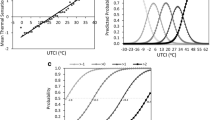Abstract
Sultriness is a specific case in thermal perception under warm/humid environments and frequently applied in German operational weather forecast and is assumed if the dew-point temperature t d exceeds a threshold of 16.5 °C. In perceived temperature (PT), which is based on the ASHRAE two-node-model, a Central European climatology was prepared of the classical predicted mean vote (PMV), exclusively linked to thermal stress, and the so-called rational PMV* that additionally accounts for the humidity in the meteorological environment and is closely linked to thermal strain. The standard deviation of the difference ΔPMV = PMV* − PMV over PMV reveals a similarity to the appearance of sultriness that suggests as side effect of the PT parameterisation a thermophysiologically based definition of sultriness: “Under warm/humid conditions a subject adapted to mild climatologic conditions perceives sultriness if the actual value of ΔPMV exceeds the long-term mean by more than its single standard deviation”. This definition accounts for all environmental and subject related variables influencing the thermal state of the body and is in accordance with all in the literature described properties in the perception of sultriness. The two definitions coincide more or less at daylight hours for t d values markedly beyond the threshold. However, in the t d threshold region, the PT-derived definition offers stronger differentiated patterns and is significantly less frequent at nighttime than the mono-causal definition. For given PT values, the sensible heat flux via the skin shows an increase under a sultry environment, whereas the latent is reduced; skin and core temperatures as well as the skin blood flow are also less. In any case, PT-derived sultriness is linked with an increased thermal strain on the body temperatures, which is a measure of discomfort caused by increased humidity and/or dissatisfaction with the thermal environment. This confirms the thermal uncomfortable feeling accompanying the perception of sultriness. Therefore, the PT-derived sultriness can be presumed to be a more appropriate measure for the perception of sultriness, because it accounts for all environmental impacts on thermoregulation.






Similar content being viewed by others
References
ASHRAE (2001) ASHRAE handbook: fundamentals, 8. American Society of Heating, Refrigerating and Air-Conditioning Engineers, Atlanta, GA, p. 29
Assmann D (1963) Die Wetterfühligkeit des Menschen. VEB G, Fischer, Jena
Castens G (1925) Über Tropenklimatologie, Tropenhygiene und den Lettow-Feldzug. Ann d Hydr LIII. Jahrg (VI):177–187
Damman W (1962) Die Schwüle als Klimafaktor. Jahrbuch der Technischen Hochschule Hannover 1960/62
Fanger PO (1972) Thermal comfort. Analysis and applications in environmental engineering. McGraw-Hill Company, pp. 244
Fiala D, Havenith G, Bröde P, Kampmann B, Jendritzky G (2012) UTCI-Fiala multi-node model of human heat transfer and temperature regulation. Int J Biometeorol 56(3):429–441. doi:10.1007/s00484-011-0424-7
Flach E (1957): Grundbegriffe und Grundtatsachen der Bioklimatologie. In: Bartels J et al.. (ed.): Linkes Meteorologisches Taschenbuch, Neue Ausgabe, Bd. III
Gagge AP, Fobelets AP, Berglund PE (1986) A standard predictive index of human response to the thermal environment. ASHRAE Trans 92:709–731
Hentschel G (1978) Das Bioklima des Menschen. VEB Verlag Volk und Gesundheit, Berlin
Herrmann H (1959) Die Schwüle, eine vergleichende Untersuchung. Dissertation, Meteorol. Institut Uni Köln
Höppe P (1984) Die Energiebilanz des Menschen. Universität München—Meteorologisches Institut, Wissenschaftliche Mitteilungen Nr. 49, 194 pp
IUPS (2003) Glossary of terms for thermal physiology. 3rd Ed. Revised by the Commission for Thermal Physiology of the International Union of Physiological Sciences (IUPS thermal commission). J Thermal Biology 28:75–106
King E (1955) Ein empirisches Schwülemaß. Medizin-Meteorologische Hefte Nr. 10:5–8
Knepple R (1948) Über die Ursachen der Schwüle. Z Meteorol 2(12):366–369
Lancaster A (1898) De la manière d’utiliser les observations hygrométriques. V. Congr. International d’Hydrologie, Climatologie, Liège, pp. 261–271
Leistner W (1951) Die hygienische und bioklimatische Bedeutung des Dampfdrucks in Innenräumen und die Behaglichkeits- und Schwülegrenze. Medizin-Meteorologische Hefte Nr 6:18–31
Malchaire J, Piette A, Kampmann B, Mehnert P, Gebhard H, Havenith G, den Hartog E, Holmér I, Parsons K, Alfano G, Griefahn B (2001) Development and validation of the predicted heat strain model. Am occup Hyg 45(2):123–135
Parsons KC (2002) Environments. The effects of hot, moderate, and cold environments on human health, comfort and performance. Taylor & Francis London and New York, second edition, pp. 518
Rothfusz LP (1990) The heat index “equation” (or, more than you ever wanted to know about heat index). NWS Southern Region Technical Attachment, SR/SSD 90-23, Fort Worth, Texas, p. 2
Scharlau K (1943) Die Schwüle als meßbare Größe. Bioklim Beibl 10:19–23
Scharlau K (1950) Zur Einführung eines Schwülemass-Stabes und Abgrenzung von Schwülezone durch Isohygrothermen. Erdkunde Band IV Lfg 3/4:188–201
Schirmer H, Buschner W, Cappel A, Schlegel M (eds) (1987) Meyers Kleines Lexikon Meteorologie. Meyers Lexikonverlag, Mannheim, Wien, Zürich
Spangenberg WW (1952) Untersuchungen zur Entstehung der Schwüle. Angewandte Meteorologie I 7:213–215
Staiger H, Laschewski G, Grätz A (2012) The perceived temperature—a versatile index for the assessment of the human thermal environment. Part a: scientific basics. Int J Biometeorol 56:165–176. doi:10.1007/s00484-011-0409-6
Steadman RG (1979) The assessment of sultriness, part I. A temperature-humidity index based on human physiology and clothing science. J Appl Meteor 18:861–873
Steadman RG (1984) A universal scale of apparent temperature. J Climate and Appl Met 23:1674–1687
Stolwijk JAJ (1971) A mathematical model of physiological temperature regulation in man. NASA contractor report NASA CR-1855, pp. 82, http://ntrs.nasa.gov/archive/nasa/casi.ntrs.nasa.gov/19710023925_1971023925.pdf.
WMO (1992) International meteorological vocabulary. World Meteorological Organization, WMO-No. 182, pp. 784
Author information
Authors and Affiliations
Corresponding author
Rights and permissions
About this article
Cite this article
Staiger, H., Laschewski, G. & Matzarakis, A. A short note on the inclusion of sultriness issues in perceived temperature in mild climates. Theor Appl Climatol 131, 819–826 (2018). https://doi.org/10.1007/s00704-016-2013-5
Received:
Accepted:
Published:
Issue Date:
DOI: https://doi.org/10.1007/s00704-016-2013-5




